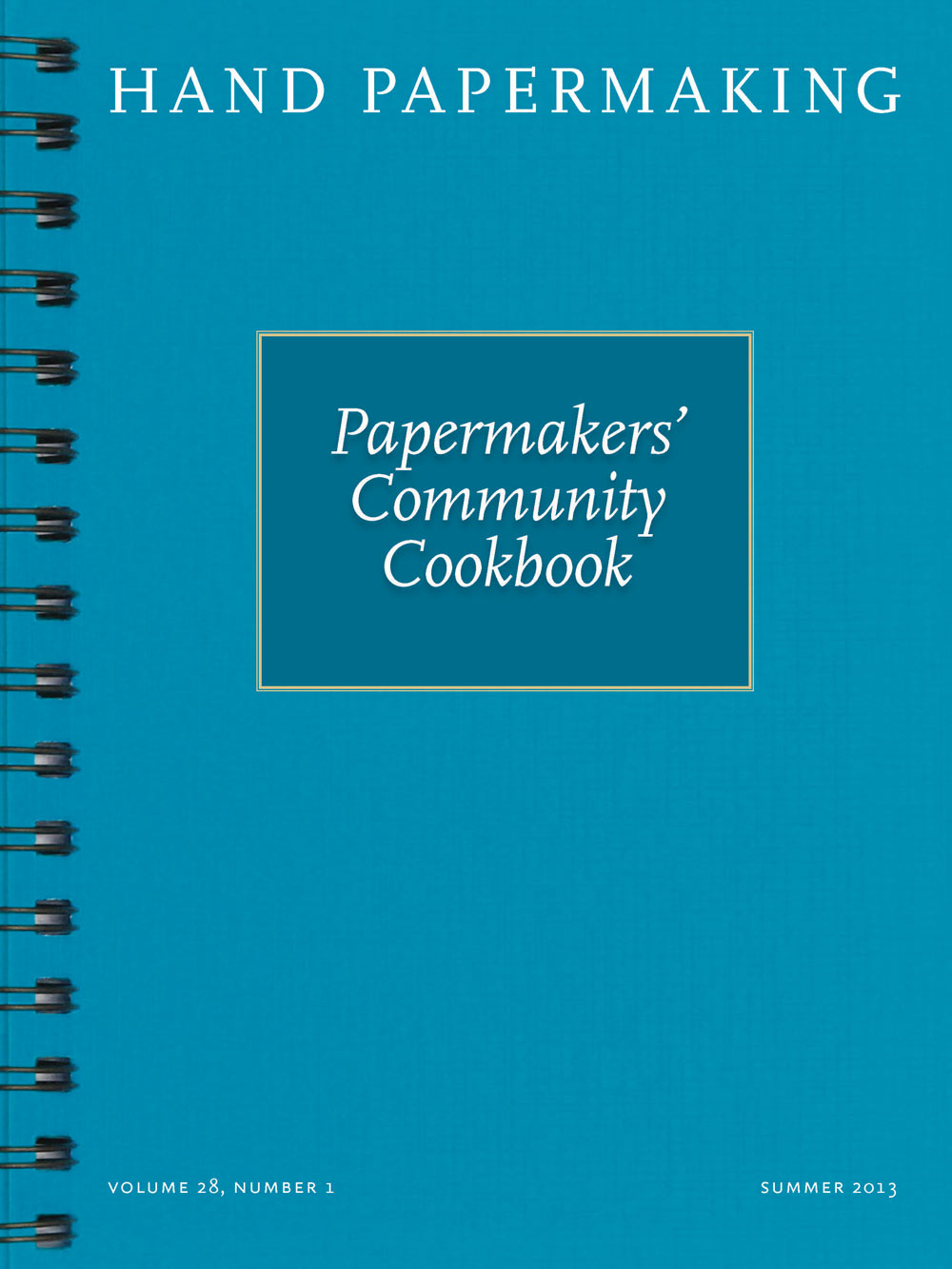The papers were left to dry at room temperature for about one day depending on the paper thickness. We sized the paper to mitigate the hydrophilic quality of the cellulose in the fiber. Sizing becomes especially relevant when making papers for aqueous drawing mediums such as ink and watercolor. For external sizing, we soaked 30 grams of alum (aluminium sulfate) and 300 grams of gelatin in 6,000 milliliters of cold water until the gelatin swelled up. We slowly heated the mixture until the alum and gelatin completely dissolved. We immersed each sheet, one at a time, in the warm sizing solution. After the sheets dried, we pressed them in a calendaring machine to refine the paper's surface: hot-pressed for smooth paper, and cold-pressed for a lessrefined surface.2 To gauge the fiber strength of the handmade banana paper, we applied a tensile-strength test to determine the required load to break the specimen, expressed per meter width (Newton per meter, N/m). We cut ten specimens, along the grain of the paper, into 25 x 210-millimeter strips, which suits the distance of two clamping jaws (180 millimeters apart) of the testing machine. We made sure that the paper strips were as consistent as possible, free from watermarks, cut edges, or other abnormalities. For comparison, we also carried out the tensile-strength test on a commercial art paper. The measurements, as indicated in Table 1, indicated that the banana paper has comparable tensile strength as that of the commercial art paper. table 1: tensile strength test TENSILE TEST LOAD (N) EXTERNAL (MM) Banana Paper 97.5 2.7 Commercial Art Paper 98.6 4 We also subjected the banana paper to the Cobb test which measures surface water absorption. The Cobb tester consists of a cylindrical container clamped to a flat base with a flexible backing onto which a test sample is placed. The test sample is weighed before it is placed into the dry cylinder. Then, 100 cubic centimeters (cc) of water is poured over the test sample. After a specified time, the water is poured off and the test piece is placed with the wet side up on a standardized, dry blotting paper. Another blotting paper is placed on top of the test sample and the excess water is removed by means of a standardized roller (two times forwards and backwards). The sample is then weighed again and the results are calculated and reported as absorbance in g/m2 according to the standard method.3 We carried out the Cobb test on waterleaf (unsized) banana paper, sized banana paper, and on sized and unsized commercial art paper for comparison. The results of the tests, as shown in Table 2, indicate that the banana papers are of a quality comparable to commercial art papers. table 2: cobb test BEFORE AFTER RESULT (g/m2) Banana 3.5 8.2 4.7 Banana (Sized) 4.2 6.1 1.9 Commercial Art Paper 6.1 10.5 4.4 Commercial Art Paper (Sized) 6 6.4 0.4 To see how the banana paper performs as a substrate for drawing and painting, we tested a number of mediums that are commonly used by artists including pencil, charcoal, ink and pen, ink and brush, acrylic, and watercolor. We experimented with a variety of drawing and painting techniques. With charcoal and pencil, we applied a range of tonal variation on the paper. For acrylic and watercolor we used both wet- and dry-brush techniques. We also gave the banana paper to well-known Malaysian artists and asked them to rate the paper using a variety of mediums. We found that the unsized, calendared banana paper is well suited for charcoal and pencil because of its smooth surface and its ability to hold charcoal and graphite particles. The paper allows good tonal variation and different qualities of line. It also exhibits a healthy resistance to rigorous erasing. For aqueous mediums such as ink, acrylic, and watercolor, we determined that the sized, calendared banana paper worked well. This paper also performed well with dry mediums. The sizing, which renders a smoother paper surface, facilitates fluid markings of pencil and charcoal. Table 3 indicates the averaged opinion of our team of paper testers. table 3: drawing test results TYPES OF PAPER MEDIUM PENCIL CHARCOAL INK ACRYLIC WATERCOLOR Banana (Unsized-Pressed) 4 4 1 3 1 Banana (Sized-Pressed) 4 4 4 4 4 1: Very Poor, 2: Poor, 3: Fair, 4: Good, 5: Very Good Our research shows that Malaysian banana fiber has excellent potential for developing high-quality, fine art papers. Banana art paper provides a good alternative for local artists and art students, allowing them to be more sustainable by reducing their reliance on expensive, imported art papers. The authors wish to acknowledge the Universiti Sains Malaysia (USM) by providing a USM Fellowship in support of this research. notes 1. Going Bananas: A Lesson in Sustainability, Compiled by USM (Penang, Malaysia: Penerbit Universiti Sains Malaysia, 2007). 2. For a discussion on different paper surfaces for the artist, see Donald Saff & Deli Sacilotto, Printmaking: History and Process (New York: Holt, Rinehart and Winston, 1978). 3. For more on a Cobb Sizing Tester, go to TechLab Systems' website: http://www.techlabsystems.com (accessed on January 20, 2013).






